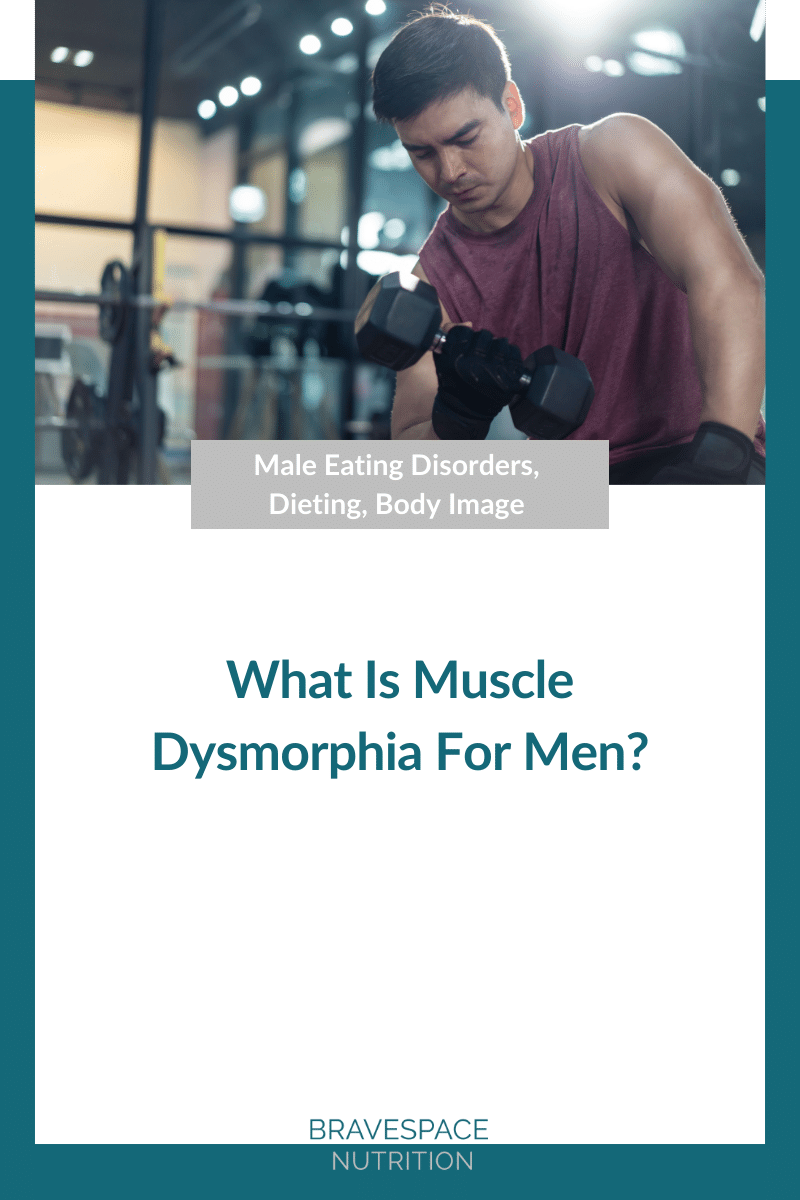What Is Muscle Dysmorphia For Men?
Of men struggling with body dysmorphic disorder, 22% of those men also struggle with muscle dysmorphia, also referred to as “big-orexia” and “reverse anorexia”.
It’s a common misconception that only women struggle with eating disorders and body image issues, but many men struggle too and more than most people assume. Researchers and clinicians are gaining more insight into male food and body image struggles that’s giving insight about just how prevalent body image issues are amongst men. One particular topic that is relevant when it comes to body image for men is muscle dysmorphia - a subclass of body dysmorphic disorder that primarily affects males.
What is body dysmorphic disorder?
Body dysmorphic disorder (or body dysmorphia) is a disorder in which individuals have an intense fixation on their physical appearance and their body’s perceived flaws. Individuals that are impacted by this believe that something is wrong physically, and hyper-fixate on a particular part (sometimes can be multiple parts) of the body.This hyperfixation can take place with any part of the body including the stomach, face, arms, legs, back, etc.
Body dysmorphic disorder impacts every 1 in 50 people and significantly decreases quality of life. Obsessions with physical appearance can create feelings of shame, embarrassment, and depression. It can also lead to social isolation, and can cause people to feel like they lack control over their life. Body dysmorphia is also a known risk factor for developing disordered eating and eating disorders. Individuals struggling with body dysmorphia often use disordered eating behaviors (like skipping meals or exercising excessively) to physically alter or manipulate their appearance.
Of men struggling with body dysmorphic disorder, 22% struggle with muscle dysmorphia.
What is muscle dysmorphia?
Muscle dysmorphia is a type of body dysmorphic disorder that was recently added to the DSM-5. This particular type of body dysmorphia is often present in males who struggle with body image. Muscle dysmorphia is defined as “the belief that one is not large enough or muscular enough” and individuals with this type of body dysmorphia have an intense fixation on becoming more muscular (1). According to the DSM-5, muscle dysmorphia involves the following criteria:
Preoccupation with one or more perceived flaws in physical appearance that aren’t observable or noticed by others
Engaging in repetitive behaviors or mental acts in response to concerns with physical appearance
Fixation on physical appearance causing significant emotional distress and impairment of daily functioning
Preoccupation with the idea that one’s body build is too small or insufficiently muscular
People with muscle dysmorphia have distorted views of their muscularity and body size, which affects their self-esteem and perceived self-worth. In order to cope with this distortion, individuals with muscle dysmorphia often engage in time consuming behaviors to enhance muscle development. This decreases quality of life, and can be all-consuming.
What are signs and symptoms of muscle dysmorphia in men?
Signs of muscle dysmorphia in men include:
Frequent experience with dieting or caloric restriction
Use of a scale to measure out meals or perfect macronutrient portions of meals
Engaging in excessive exercise, often exercising for multiple hours a day
Exercising despite injury, illness, or pain
Avoidance of social interactions in order to exercise
Avoidance of social interactions that involve food
Strict adherence to calorie counting and distress if unable to count calories (such as eating at restaurants)
Avoiding eating at restaurants out of the fear that food is being prepared by someone else
Excessive use of dietary supplements to enhance health and/or gain muscle
Anxiety or distress if unable to maintain a particular exercise regimen
Use of a rigid schedule to determine when to eat or how much to eat (disregarding intuitive hunger/fullness signals)
Avoidance of mirrors or excessive use of mirrors to body check appearance
Belief that there is a perfect macronutrient formula
Wearing baggy clothing or multiple layers of clothing to appear larger or hide one’s appearance
Use of steroids and performance enhancing drugs to increase muscularity
Who is at risk for having muscle dysmorphia?
Though muscle dysmorphia is more common in men, women can also struggle with muscle dysmorphia. Any person of any gender can struggle with body image; however, males are primarily affected by muscle dysmorphia.
Expectations set by diet and wellness culture are incredibly harmful to male body image and can cause you to develop muscle dysmorphia. Men are told by the media that to be sexually desirable or attractive, they must be lean and have huge muscles, ripped abs, and look “shredded”. The media portrays this “optimal” male appearance that tells males what they should look like. In reality, these body “ideals” created by cultural influences are unattainable and incredibly unrealistic and can result in the abuse of steroids and medications to maintain such body ideals.
Men and women traditionally face different societal expectations when it comes to body “ideals''. Women are taught to pursue thinness, while men are taught to pursue building muscle and becoming larger. With that being said, a man can still struggle with a desire to be thinner, and a woman can struggle with wanting to increase muscularity. Either way, both can be incredibly harmful to one’s self-esteem and mental health.
You are at an increased risk for muscle dysmorphia if you:
Live with someone who has struggled with body dysmorphia and/or disordered eating
Have relatives or friends that have struggled with body dysmorphia and/or disordered eating
Have experienced bullying or teasing about your physical appearance
Have experienced some sort of trauma
Struggle with other mental health conditions (anxiety, depression, OCD, ADHD, etc.)
Compete in bodybuilding competitions or weightlifting/bodybuilding for physical exercise
Have worked for or currently work for the military
What are the risks of muscle dysmorphia for men?
Muscle dysmorphia is a particularly dangerous type of body dysmorphic disorder that has drastic, long-lasting effects on the body. Some risks are:
Using steroids and performance enhancing drugs - Muscle dysmorphia often causes individuals to use steroids and other performance enhancing drugs to achieve their desired physical appearance. There are serious long-term implications of using such substances including but not limited to:
Decreased fertility
High cholesterol
High blood pressure
Liver tumors
Impaired growth (in cases of adolescents or teens)
Increased anger and emotional distress
Endocrine issues, including need for testosterone therapy
Worsening or developing mental health struggles - Muscle dysmorphia can cause other mental health conditions to develop or worsen. Intense fixations of exercise, nutrition, and appearance can cause social isolation, as well as feelings of anxiety and depression.
Suicide or worsening thoughts of suicide - Research has indicated that out of those who struggle with muscle dysmorphia, nearly 50% of individuals with muscle dysmorphia have had at least one suicide attempt.
Mood swings - Muscle dysmorphia can cause you to have intense mood swings that can have serious, negative impacts on your life and relationships.
Malnutrition - Strict adherence to particular eating habits can impact your nutrition status and can lead to malnutrition. A lack of diversity in food means that you are eating a lot of certain vitamins and minerals and not getting enough of others. It’s important to eat a varied diet to ensure that your nutrition intake is enough to sustain your exercise and daily routines.
Is muscle dysmorphia an eating disorder?
While eating disorders can coexist with muscle dysmorphia, they aren’t necessarily one in the same. Muscle dysmorphia is not the same thing as an eating disorder. Muscle dysmorphia is a type of body dysmorphic disorder that can lead to disordered eating behaviors and eating disorders. Research shows that negative body image can be a precursor to developing eating disorders. There is evidence of correlations between muscle dysmorphia and eating disorder symptomatology, including behaviors like compulsive exercise, diet pill use, vomiting, and laxative use.
While muscle dysmorphia presents differently than other types of body dysmorphic disorders, any type of body dysmorphia can lead to disordered eating behaviors.
What about if you lift weights or bodybuild, does that mean you have muscle dysmorphia?
It’s possible to have a positive relationship with lifting weights and body building and not have muscle dysmorphia. The differences between a disordered relationship with lifting bodybuilding and a healthy relationship with lifting and bodybuilding are:
The source of self-esteem and self-confidence in a disordered relationship with exercise relies entirely upon muscularity and physical appearance. Those with muscle dysmorphia base their self-worth on their body size and muscle size.
In muscle dysmorphia, you have difficulty seeing your body for what it actually looks like and your perception of yourself can interferes with your daily life, including work, school, relationships, and mood.
A healthy relationship with exercise does not involve the use of substances to alter your appearance. If you are using steroids or performance enhancing drugs, this indicates that you may be struggling with muscle dysmorphia.
If you feel that you have an inaccurate perception of your physical appearance or that you identify with any of the signs and symptoms of body dysmorphia, it’s possible that you may be struggling with muscle dysmorphia.
Here are 5 things you can do if you are a man struggling with muscle dysmorphia:
1.Understand that societal expectations of the male appearance are often unattainable.
There are things going on behind the scenes that you can’t see. The images you see in the media of ripped men that have minimal body fat and huge muscles are often edited images. Fitspiration content is false content. The truth is, male actors and celebrities with these body types often engage in disordered exercise, disordered eating behaviors, and use of substances and medications to enhance physical appearance. You aren’t being told the whole story, and you don’t deserve to feel like a failure because you can’t achieve these unattainable body types.
2. Believe that you are more than your physical appearance.
Societal norms and diet culture have taught you to attribute so much of your self-esteem and self-worth to physical appearance. You are so much more than your body! You are more than the amount of muscle you have or how shredded you are, and your appearance does not dictate your worth.
3.Understand that while you may feel in control, the muscle dysmorphia is in control.
Struggles with body image can often feel like a battle for control, whether you want to control your physical appearance, something unrelated in your life, or both. While you may feel like your exercise and eating behaviors bring control to your life, this feeling is a false, temporary sense of control. Engaging in muscle dysmorphia behaviors leaves you with less control over your life, and can leave you feeling helpless and lost.
4. Seek help for your body image struggles.
You are capable and deserving of positive body image. You deserve a life free from muscle dysmorphia and body image struggles, and you deserve a healed relationship with your body. Cognitive behavioral therapy (CBT) and anti-diet dietitians can help you heal your body image and cultivate a positive relationship with exercise and food. It can be scary to seek help, but it’s even scarier to remain under the control of your muscle dysmorphia.
5. Know that you aren’t alone in your struggle.
You are not alone in your struggle with muscle dysmorphia. There are so many other men (and people of other genders) who have fallen victim to the toxicity of lifting and gym culture. Men traditionally are less likely to speak out about struggles with food, exercise, and body image, and there has historically been a lack of support resources available to men. The good news is, this is changing! Everyday, more and more men are speaking out about their experiences with muscle dysmorphia and body image struggles.
You’ll also love…
Are you a man that’s struggling with your body image? Do you feel like you might have muscle dysmorphia?
Muscle dysmorphia can gain complete control over your life. It’s exhausting and discouraging to live your life feeling like you’re not in the driver's seat, and it can be disheartening feeling like you’re alone in this experience. But you don’t have to heal and recover alone! Bravespace Nutrition is here to help. Our Seattle, WA-based virtual eating disorder dietitians are here to help you break free from muscle dysmorphia and male body image and eating disorder struggles. Our eating disorder dietitian nutritionists are equipped to help you cultivate positive body image and heal your relationship with food and exercise. To get started today, follow these simple steps:
Meet with one of our dietitians virtually.
Begin your journey of healing your body image!




